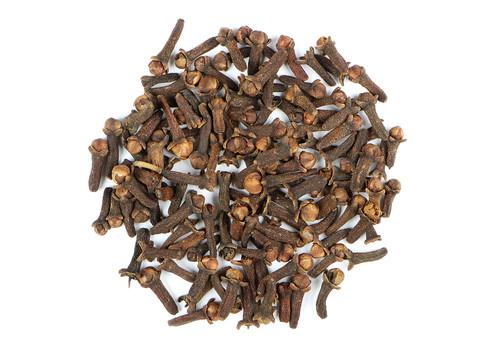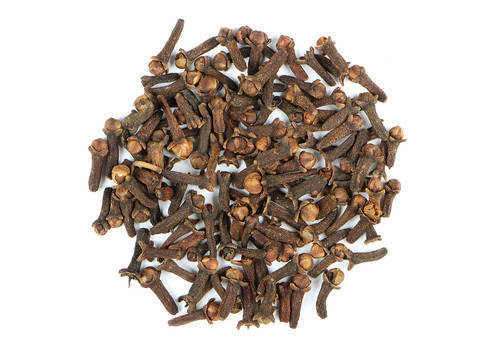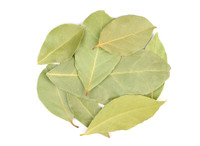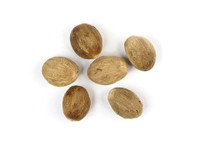-
Product Description
COMMON NAME
Standardized: clove
Other: cloves, lavangaBOTANICAL NAME
Syzygium aromaticum (L.) Merr. & L. M. Perry1
Plant Family: MyrtaceaeSYNONYMS
Caryophyllus aromaticus, Eugenia aromatic, Eugenia caryophyllata 1OVERVIEW
An extensively utilized culinary spice since ancient times, clove rivals other well-known spices such as cinnamon, ginger, and nutmeg for popularity. Clove is used in liqueurs and mulled wine, perfumes and even love potions. More recently, clove oil has been employed for its analgesic effects in dentistry.4-7BOTANY
Clove is a small evergreen tree with smooth gray bark and large, bright green, aromatic and lanceolate shaped leaves. The flowers grow in yellow to bright red clusters at the end of branches.8 It is in the Myrtaceae family, with relatives ranging from guava to allspice to eucalyptus.1 The clove of commerce is the pink or reddish flower bud that turns dark brown when dried.4 The entire tree is highly aromatic8 and its Latin specific name aromaticum, refers to this intense aroma. The generic name Syzygium is based on the Greek word 'syzygos', that means 'paired or joined' and is in reference to the petals which are joined.3 The common name 'clove,' a derivative of the Latin 'clavus' meaning 'nail,' and refers to the shape of the clove.2,3 Clove is native to the Maluku or Molucca Islands (often referred to as the Spice Islands, due, in part, to the abundance of clove) in Indonesia.1CULTIVATION AND HARVESTING
Clove is widely cultivated in Tanzania, Indonesia, Madagascar, Malaysia, Sri Lanka, and South America9 with Tanzania being the largest commercial cultivator.9,10 Zanzibar and the Island of Pemba, both parts of Tanzania, were once represented by a flag with two clove buds representing the influence of this spice in the region.3HISTORY AND FOLKLORE
Clove has been utilized as a culinary spice for thousands of years. It is believed that spice found in a ceramic pot in Syria dating to around 1,700 BCE may have been clove.11 Also, trade between the Molucca Islands, where the clove grows natively, and China goes back at least to some 2500 years ago.3 During the Han dynasty, it was customary for court officials to hold cloves in their mouths to freshen their breath while addressing the emperor.3 Clove was initially brought to Europe in the 4th century by Arab spice traders3,8 and by the 16th and 17th centuries, the Portuguese were attempting to hold onto the monopoly that they had on the clove spice trade.11 However, the Dutch East India Company (referred to in Dutch as the Vereenigde Oostindische Compagnie or 'VOC') gained control in the early 17th century. According to Jack Turner in his book Spice: The History of a Temptation: "After the final expulsion of the Portuguese in 1605, the VOC set about making each and every clove on Earth a Dutch possession."11Turner also went on to infer that the Dutch guarded the clove "as ever a jealous lover watched his sweetheart" because apparently there was quite a lot to gain.11 The markup on clove was nearly 2,000 percent, and further, to maintain such artificially high prices, often hundreds of thousands of pounds of spices were set aflame in huge bonfires.11 Eventually, a Frenchman named Pierre Poivre, started stealing the highly guarded seedlings and sending them to French colonies in the tropics, making it possible for other countries to grow this crop and, thus, ending the monopoly of the VOC.10,11 In the early 1800's the British got involved and began to establish plantations in Tanzania which has grown into the largest clove exporter.10Traditionally, in the Molucca Islands, a clove tree was planted each time a child was born leading to the abundance of the this spice.11 Various folk tales and myths surround clove as it was believed to be imbued with the magical powers of protection, love, and, burned as incense to attract financial abundance.12 Further, it was thought that burning it as incense would stop others from gossiping about you. Additionally, it was used in exorcisms to expel evil spirits.12
Used extensively in Middle Eastern, north African, Chinese (in their '5 spice powder') and Indian cuisine.3 It is also indispensable in 'chai,' a spicy Indian tea which also contains cardamom, cinnamon, ginger, black peppercorn and black tea and also in garam masala, an Indian culinary spice used in curries, containing turmeric and a variety of other spices.3 The strong flavor of cloves isn't as appreciated in other countries and is mainly used as a flavoring in various baked goods such as gingerbread.3 Interestingly, cloves are not used much for cooking in their native homeland of the Molucca Islands, but rather are extremely popular as cigarettes.3 In Ayurveda (system of traditional healing in India), clove, referred to as 'lavanga,' has not only been used in the kitchen, but has been employed as a medicinal herb to support digestion, soothe nausea, to support lung health, and is thought to be a highly effective carminative. It is considered to be an energetically hot herb having a pungent taste and therefore most useful in cold or stagnant conditions.2 Likewise in TCM (Traditional Chinese Medicine), clove is considered a warming herb that breaks up stagnant energy by encouraging chi (energy) flow, and is used to support the kidney, spleen, and stomach meridians.13
The main component in the volatile oil is eugenol6 (cinnamon also contains high levels of this constituent)14 thought to be responsible for clove's analgesic effects.
FLAVOR NOTES AND ENERGETICS
Highly aromatic and pungent.2 Heating.2,13USES AND PREPARATIONS
Dried flower buds powdered as a culinary spice or as part of a tea blend.PRECAUTIONS
Consumption should not exceed small amounts for use as a spice. Consult a qualified healthcare practitioner before using in therapeutic doses.
We recommend that you consult with a qualified healthcare practitioner before using herbal products, particularly if you are pregnant, nursing, or on any medications.REFERENCES
United States Department of Agriculture Agricultural Research Service, Beltsville Area Germplasm Resources Information Network (GRIN). Accessed at http://www.ars-grin.gov/cgi-bin/npgs/html/taxon.pl?40944#syn on August 24, 2014.
Khalsa Singh KP, Tierra M. The way of Ayurvedic herbs. Twin Lakes: Lotus Press; 2008.
Gernot K. Katzer's Spice Pages. Cloves (Syzygium aromaticum [L.] Merr. et Perry) Accessed at: http://gernot-katzers-spice-pages.com/engl/Syzy_aro.html on August 24th 2014.
Blumenthal M, Busse WR, Goldberg A, Gruenwald J, Hall T, Riggins CW, Rister RS, eds. Klein S, Rister RS, trans. The Complete German Commission E MonographsTherapeutic Guide to Herbal Medicines. Austin, TX: American Botanical Council; Boston: Integrative Medicine Communication; 1998.
Alqareer, A., Alyahya, A., & Andersson, L. (2006). The effect of clove and benzocaine versus placebo as topical anesthetics. Journal of dentistry, 34(10), 747-750.
Barnes, J., Anderson, L. A., & Phillipson, J. D. (2003). Herbal medicines: a guide for healthcare professionals (No. Ed. 2). Pharmaceutical Press.
Select Committee on GRAS Substances (SCOGS) Opinion: Clove Bud Oil. US Food and Drug Administration. Accessed on August 24, 2014.
Grieve M. A Modern Herbal. New York: Dover Publications, Inc. Accessed at http://botanical.com/botanical on August 19, 2014.
Mansfeld's World Database of Agricultural and Horticultural Crops. Accessed on August 24, 2014.
Professor Arthur C. "Plants and Civilization." Clove. 1984. Accessed on August 24, 2014.
Turner, Jack (2004). Spice: The History of a Temptation. Vintage Books.
Cunningham, S. Cunningham's Encyclopedia of Magical Herbs. Woodbury: Llewellyn Publications; 2000.
Bensky, D., Gamble, A., & Kaptchuk, T. J. (1993). Chinese herbal medicine: materia medica.
Mallavarapu, G. R., Ramesh, S., Chandrasekhara, R. S., Rajeswara Rao, B. R., Kaul, P. N., & Bhattacharya, A. K. (1995). Investigation of the essential oil of cinnamon leaf grown at Bangalore and Hyderabad. Flavour and fragrance journal, 10(4), 239-242
Additional Resources:
Worrall, Simon (June 23, 2012). "The world's oldest clove tree". BBC News Magazine.This information has not been evaluated by the Food and Drug Administration. This product is not intended to diagnose, treat, cure, or prevent any disease. For educational purposes only.
-
Product Reviews
-
Find Similar Products by Category








